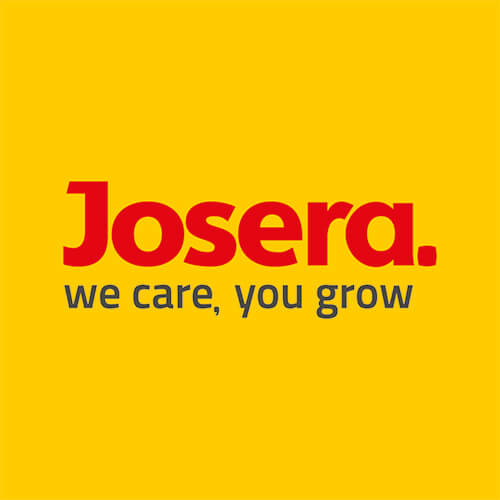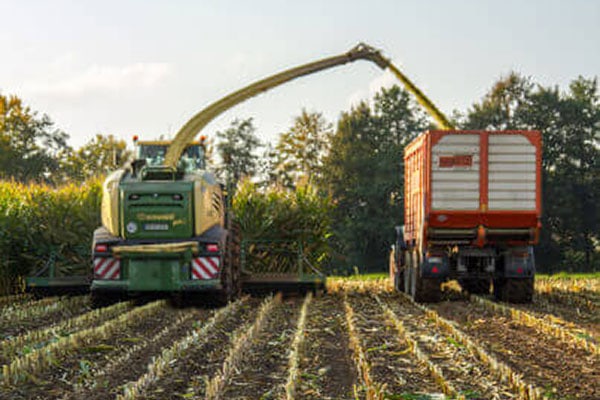The maturation of maize plants
Maize silage is an ideal energy-rich supplement to grass silage.
High-quality maize silage is tasty and increases the basic feed intake. It also combines a good crude fibre content with a high energy content. You need to know the development status in the field to be able to determine the optimum stage of maturity of the maize plant. Ripening follows the date of sowing (variety) and the weather.
The dry material content of the plant can lose up to half a percent depending on the weather. The right time of harvest is therefore different every year. The aim is a dry material content of maize plants of 30–35%; the cob dry material content should be 50–60%.
The maturity development of maize plants in three stages:
- Milk maturity
- Dough maturity
- Grain maturity

The development of the grain or the “milk line” provides an indication of this. It separates the liquid from the solid part of the grain. The solid part of the grain should take up half or two thirds of the grain at silage maturity (beginning to middle of dough maturity). The grain dry mass is then 63–64%, and the dry matter content in the piston is 45–55%. However, because the different maturation processes of grain and residual plant, grain maturation can only be a guide in determining the optimum harvest time for silage maize.The dry matter content of the remaining plant should not exceed 24% so that not too much indigestible crude fibre is stored, thereby decreasing the digestibility. This results in a dry matter content of 30–35% of the total plant. Varieties with slow residual plant maturation only reach their optimum in the range of 37–38% dry matter content in the whole plant.
Target values for optimum maize silage
| Dry matter of the whole plant | 30 – 35% |
| Raw protein | 70 – 90 g/ kg dry matter |
| Crude fibre | 170 – 200 g/ kg |
| net energy lactation | over 6.5 MJ NEL / kg dry matter |
| Starch and residual sugar | over 300g / kg dry matter |
| NDF | 35 – 40% in dry matter |
The right time to harvest
Harvesting at the recommended stage of “dough maturity” brings the most advantages.
Quick lactic acid fermentation is achieved by good compaction and substances with sufficient potential for fermentation (starch, sugar). The result is tasty and energy-rich maize silage. This is also valid for the use of a heterofermentative means of silage, in this case protect it from aerobic spoilage from yeasts and moulds as well as possible.

What happens if the harvest is too early?
A harvest that is too early leads to yields that are too low. The energy content is reduced by incorrect starch storage. High loss of conservation may also occur from fermented liquid.
What happens if the harvest is too late?
A harvest that is late causes problems with filling and compaction in the silo. Hard plant parts that are too dry are harder to compact. The risk of reheating and mould formation is higher. This is especially because dead parts of the plant with harmful microorganisms (yeasts) are affected, particularly for plants with frost damage.
Solutions for a perfect harvest
Lower dry substance contents lead to leachate and can delay the ensiling process. This results in an overall loss of nutrients.
The use of Josilac combi helps here. The biological silage additive accelerates the lowering of the pH value and thus reduces nutrient losses and the propagation of fermentation pests. At the same time, heterofermentative lactic acid bacteria ensure good silage stability.
If the dry material content is above the target value, the risk of reheating increases, especially in connection with poorer compaction. This also means loss of energy and thus reduced palatability and digestibility. Josilac ferm and Josilac extra prevent the development of yeasts and moulds and thus stabilise a nutrient-rich and tasty maize silage.

The optimal ensiling technology
Chaff length
There are important points to be observed even in silo filling. If there is enough maize in the field, it makes sense to think about a higher cutting height. The energy content can be increased by a low proportion of stalks in the silage.
The optimum cutting height is in the range of 5–8 mm (theoretical chaff length). Above all, this depends on the level of maturity of the plant. The higher the dry material content, the shorter the plant should be chopped to ensure good compaction. However, chaff lengths that are too low run the risk of negatively influencing the structure of the maize silage. The setting of the grain cracker also needs to be checked because only maize grains that have been struck can be digested by the cow.
Compacting
The most important thing during ensiling is the compaction in the silo stock. Here it is important that the roller tractor and not the forage harvester driver determine the filling speed in the field. A storage density of more than 250 kg/dry material per m³ of silage is used as a guide. This is achieved by a max. compacting layer height of 20–30 cm (tilt evenly over the entire length of the silo). The weight of the roller vehicle should be approximately a third of the container production per hour. For modern cutting output, it is often useful to use two roller vehicles or to fill two silos at the same time.
The ensiling process takes time. The silo should therefore only be opened after a min. of 6 weeks. “Loosening” of the silo should be avoided on removal. In general, the size of the silo must match the animal population. Sufficient feed can only be prevented from reheating in this way. The aim in summer is a feed of 2.5 m a week.

The use of Josilac® in the maize harvest
Silo maize and the situation of the harvest 2019 – watch the video of the recommendation of our expert!
The use of Josilac® in the maiz harvest- a video about the practical use.
You might be interested in the following contents:
Ensiling made easy
Would you like to feed your cows with a high-quality silage, and facilitate excellent dry matter consumption? Do you want to increase the yield of your dairy cows and at the same time sustainably stabilise the health of your animals?
NEW: Turbo, Safety and Symbiosis – Effect
Since the market launch and the now 20 year existence of the silage inoculant brand “Josilac”, there has been and is still a constant development and progression process. Josilac is used in over 25 countries all over the continent. Read more about the future challenges of milk production!







